Nathan Sawaya Uses What Art Medium to Make His Sculptures
The centerpiece of Nathan Sawaya's whimsical collection of Lego sculptures is Yellow–a so-hued body of a human being fierce open his chest to unleash a cascade of plastic bricks.
It's a kind of self-portrait by an creative person at ane with his medium; information technology'southward "almost my transition opening up to the world," says Sawaya. Yellow has struck a pop civilisation nerve, landing on T-shirts, jackets, a European rock band album cover, and logo for a Philadelphia DJ. "Not all of them are licensed, only I was a lawyer, and then it's all worked out very nicely," he laughs.
Since making the seemingly crazy jump from corporate chaser to Lego creative person in 2004–while $100,000 in debt from pupil loans–Sawaya has garnered an international reputation, stints on the late-night and morning time talk bear witness circuits, and a consultancy on Mythbusters. He's picked up an eclectic assortment of celebrity clients–Donald Trump, skateboarding icon Tony Hawk, Fall Out Boy'south Pete Wentz, and, nigh notably, Neb Clinton–a longtime fan whose desk sports a Sawaya Lego globe. For 6 years, his Art of the Brick solo evidence has toured eight countries in North America, Europe, and Asia. He's as well compiled two books–Art of the Brick in 2009 and last year'southward The Fine art of Nathan Sawaya. His works command from $10,000 to six figures. At whatever given fourth dimension, his New York studio houses ii.v million Lego bricks.
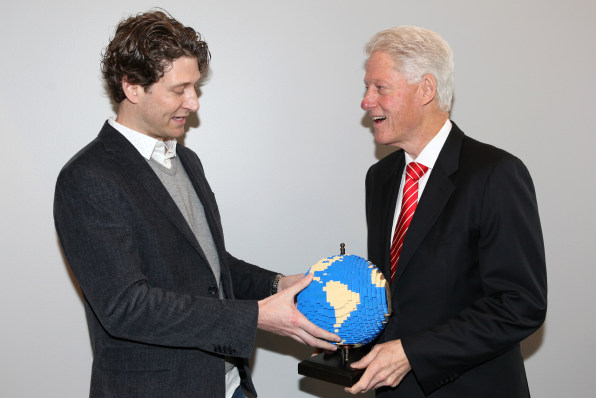
Sawaya's latest effort is In Pieces, a 2-year collaboration with the Toronto-based Australian hyper-realistic photographer Dean W. West's seven photos subtly incorporate Sawaya'south Lego objects, not to mention an artist cameo. The showroom premiered December. 10 at the William J. Clinton Presidential Center Library in Little Stone, AK (which presented Art of the Brick last year) and will run through Feb. 1 earlier moving to a to-exist-appear New York gallery. Sawaya and W will appear at the Clinton Library Jan. xiv.
"At that place's a fun, nostalgic aspect to Legos–people connect to the fine art on a different level," says Sawaya. "But it's also a medium that lets me design annihilation I can imagine. I especially enjoy creating curvy forms using rectangular pieces. Upwardly close, yous notice the sharp angles, just when you back away, the corners blend into curves. There'south a magic in the perspective."
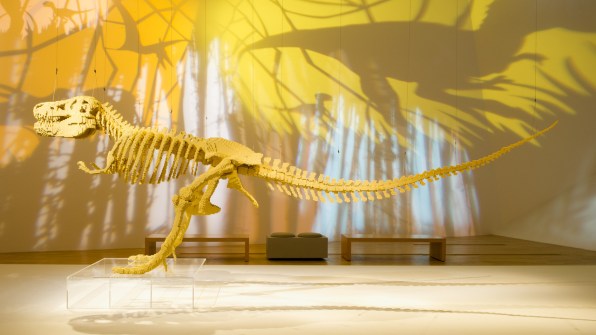
The Zen of Lego
Sawaya drops some six figures on Lego bricks every yr, with some statues–similar the twenty-feet-long Tyrannosaurus rex skeleton he built for Singapore'due south ArtScience Museum over a summer of eight- to 12-60 minutes days–commanding 80,000 bricks.
Sawaya showtime sketches his sculpture ideas on brick newspaper, occasionally using Lego Digital Designer software, which has virtual bricks programmed with gravitational physics, for positioning. As he builds, he glues each slice in place. "I've done projects where I've had to chisel away days of work. Simply on the whole, it's really therapeutic for me; I get into a kind of trance. I'll oftentimes match the groundwork music to where I am in the process.
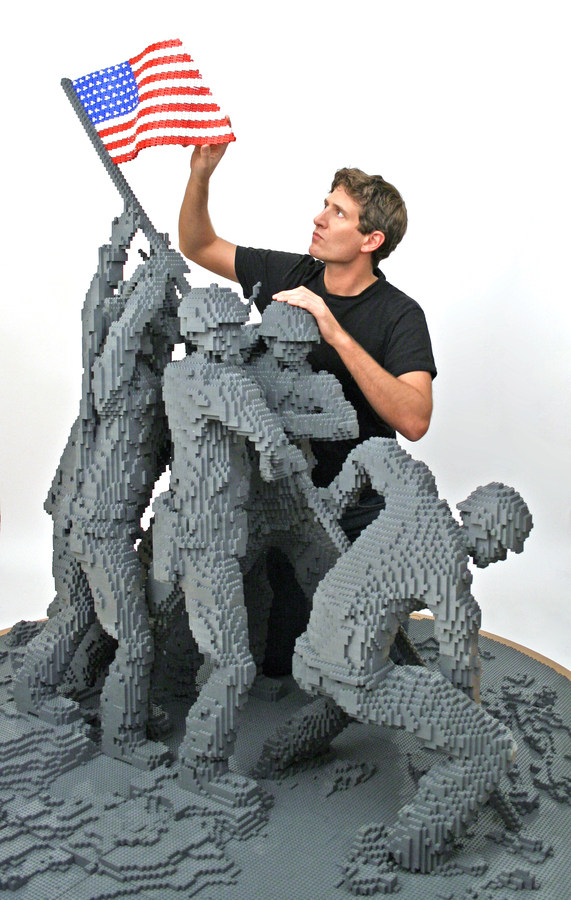
"Gravity is the nigh interesting part of this work," he adds. "A concept will look great on paper, but until I actually build it, there'south a lot of technology trial and fault. One of the more difficult pieces was a replica of the Iwo Jima flag-raising statue for the National Museum of the Marine Corps in Quantico, VA, which wanted to use information technology to teach kids about history. In the photo, five marines are all leaning on the flagpole, which is dandy if it'southward made of bronze. It took a while to effigy out, but I have an innate sense of what will and won't work, and at what point it'south going to topple over. Don't ask me to explicate it."
His art'south dialogue with children is another integral element. "They're seeing the art world in a whole new way," says Sawaya. "Kids can't build a marble statue at habitation. Simply I've had parents tell me that, afterward an showroom, their kids immediately dug out their Lego kits and disappeared for three days."
He returned the inspirational favor with a post-Katrina commission for the New Orleans Public Library that celebrated the urban center'southward rebirth. "I collected hundreds of drawings from children about what was important to them," he says. "They drew hospitals and fire stations in vivid colors. The buildings were kind of crooked; the windows didn't line upwardly; ane of the hospitals was pink. I tried to capture the expect of those drawings. It turned into a giant hand property this colorful metropolis."
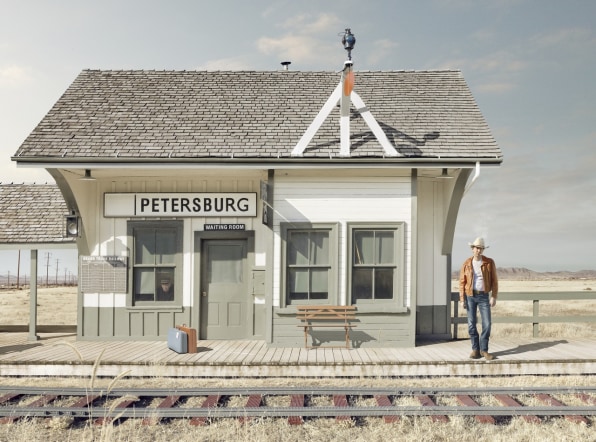
The Neat Leap
As a child, Sawaya engaged in drawing, painting, magic, cartooning and storytelling, just chose a safer route every bit an developed.
"What exercise young, budding artists practise, merely get to constabulary school?" quips Sawaya, who graduated from New York University Schoolhouse of Law in 1998 and went to work in the Manhattan part of the international legal house, Winston & Strawn. "I had creative periods now and over again, but it wasn't until I was practicing law that I really needed a artistic outlet. I'd come up home from long days at the part and draw, paint, and sculpt from clay, wire–even candy. I liked the concept of something additive in nature–where small pieces atomic number 82 to a larger course. That's when I thought, 'What about this toy from my childhood?'"
Sawaya began challenging himself with big-scale sculptures. But when he put together a website and commissions started rolling in from around the world, "that took it to a whole new level," he says. "I realized, 'I can make coin from this.'"

And then his dual life began: corporate lawyer by 24-hour interval; Lego artist late into the night. He carried on like this for 18 months until one seminal consequence in January 2004: "The day my website crashed from too many hits, I knew it was time to make some changes," he says. "I decided to leave the law firm."
Reactions were mixed. "My family was quite supportive–they had suffered through my beingness a lawyer," he says. "My colleagues were kind of jealous that I was following my passion. My bosses were confused. I was going from a very steady, secure life with a half-dozen-figure bacon to i total of risk, non knowing if I'd be able to pay rent. The scariest office for me was nonetheless having over $100,000 in pupil loans to pay back. Every time I got a committee, I thought,'This volition probably be the last one for the month.'"
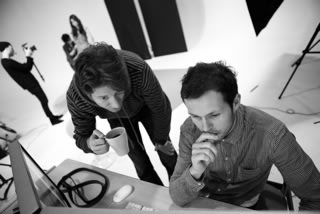
Despite occasional lean periods, there was enough work to keep him afloat without his having to take a part-time job. In 2007, the Lancaster Museum of Art in Lancaster, PA sponsored his first solo exhibition, Art of the Brick, and his art took off. The exhibit has continuously toured, often breaking attendance records. It also defenseless the attending of Due west, who approached Sawaya about collaborating. By 2010, occasional Skype and coffee shop brainstorms turned into four-day location scouting trips in the desert. "Collaborating came really easily–having him equally an artist, agreement what I was trying to do," he says. "At that place are days when I really miss that."
Although his hire worries were long past, Sawaya realized he'd arrived while talking to Clinton during Fine art of the Brick's run. A trivial boy approached them and asked for a photo.
Clinton began to comply, when the boy blurted, "Not you–the Lego guy!"
Click through the slide show higher up for selections from Art of the Brick and In Pieces.
Source: https://www.fastcompany.com/1682144/making-lego-into-art-nathan-sawayas-impossible-brick-sculptures